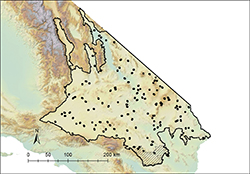One might say that a groundbreaking new study conducted by two CDFW scientists and their research partners provides a leap forward in lizard research.

CDFW scientists conducted a groundbreaking survey of lizards across the entire Mojave Desert. CDFW graphic.
One might say that a groundbreaking new study conducted by two CDFW scientists and their research partners provides a leap forward in lizard research.
Dr. Brett Furnas, a senior environmental scientist with CDFW’s Wildlife Investigations Lab, is the lead author on a paper entitled  Hierarchical distance sampling to estimate population sizes of common lizards across a desert ecoregion. The co-authors on this paper are Scott Newton and Griffin Capehart, both formerly contractors for the Wildlife Branch at CDFW, and Dr. Cameron Barrows with the Center for Conservation Biology at the University of California, Riverside.
Hierarchical distance sampling to estimate population sizes of common lizards across a desert ecoregion. The co-authors on this paper are Scott Newton and Griffin Capehart, both formerly contractors for the Wildlife Branch at CDFW, and Dr. Cameron Barrows with the Center for Conservation Biology at the University of California, Riverside.
According to Furnas, monitoring programs that survey many wildlife species at the same time across large geographic regions are important for informing conservation decisions, but reptiles are often missing from these efforts because they are difficult to survey. Therefore, the researchers applied a new distance-sampling approach to more accurately count lizards across the entire Mojave Desert within California (25,803 square miles in total).
“As far as we know, this is the first time a lizard population has been accurately enumerated over such a large area of desert,” said Furnas.
Visual surveys of lizards were conducted in 2016 along quarter-mile long transects at 229 widely dispersed sites throughout the desert. The surveys were repeated several times during the same month, which allowed CDFW scientists to correct for lizards that were missed during any one visit due to hot weather and other factors. The researchers validated their results by comparing them against a different set of surveys conducted by Barrows over a much smaller area at Joshua Tree National Park.
After using advanced statistical models to extrapolate survey results across the entire desert, CDFW estimated 82 million lizards for the three most common species of lizards across an area amounting to 16 percent of the total land area of the state. The population numbers reflect an average of 3,170 lizards per square mile.
“Having a good measure of population size for any species is important because it allows us to make more effective conservation decisions when we know how abundant a species is, what habitats is uses, and whether it is increasing or declining in numbers,” Furnas said. “These are often the first questions decision-makers want answers to.”
This is especially important in the deserts of California and the Southwestern United States, which are already experiencing severe increases in temperature and reductions in rainfall due to climate change. There is concern that these increases in temperature may already be exceeding the physiological limits of some lizard species, thereby increasing their risk of extinction.
“Lizards and other reptiles are particularly sensitive to temperature, in part because they are ‘ectothermic,’” explained Furnas. “Unlike mammals, reptiles cannot use their metabolism to regulate body temperature; instead they may need to take shelter on very hot days, which may limit the time they can spend foraging for food.”
In addition to demonstrating the value of a new method for monitoring reptiles, the study was able to map the distribution of lizards throughout the Mojave Desert and show how population levels and the behavior of lizards vary with differences in vegetation cover, human land use, and temperature. Of the three species studied, Western Whiptail (Aspidoscelis tigris) and Common-side Blotched Lizard (Uta stansburiana) were more abundant in cooler places found at higher elevations or where there was greater vegetation cover. On the other hand, Zebra-tailed Lizard (Callisaurus draconoides) was more tolerant of high temperatures, but was the most sensitive to human development and disturbance.
CDFW Photo and Graphic. Top Photo: This common side-blotched lizard (Uta stansburiana) was surveyed at Joshua Tree National Park. CDFW Photo by Cameron Barrow.
###
Media Contacts:
Kyle Orr, CDFW Communications, (916) 322-8958
Brett Furnas, CDFW Wildlife Investigations Laboratory, (530) 227-3998